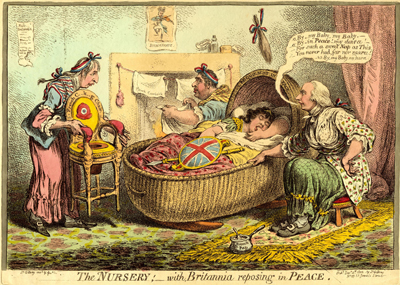The Nursery, with Britannia Reposing in Peace
This is one of several prints by Gillray published in the wake of the Treaty of Amiens officially signed on March 25, 1802 which brought peace between France and England for the first time since April of 1792. At first, the treaty negotiated by the new Prime Minister Henry Addington and his Secretary of State for Foreign Affairs, Robert Jenkinson, Lord Hawkesbury, was greeted with joy and relief. The Whigs had been calling for peace for years. And British citizens were tired of the conflict and the increased taxes on seemingly everything that were required to support it.
But it was not long before buyer's remorse set in. Less than eight months after the signing, The Nursery shows that Gillray, at least, saw the peace that had been purchased by the Treaty in a very different light.

© Trustees of the British Museum
In the center of the print, we see the once stately, strong, and womanly Britannia of painting, sculpture, and coinage now reduced to a thumb-sucking infant with a corresponding diminution of her shield and spear. The three men most responsible for this transformation act as nursemaids. The foreign Secretary Hawksworth brings over a highchair/commode for the baby Britannia. The Whig leader, Charles James Fox hangs up her diapers to dry before the fire. Prime Minister Henry Addington sings as he rocks her cradle.
o, By - my Baby, my Baby, -
o, By - in Peace! my dearee! -
For such a sweet Nap as This,
You never had, far nor nearee!
- so. By - my Baby, my dearee!'
Evidence of French influence or domination is everyhere. The three nursemaids all wear tri-colour ribbons in their hair. The birch switch used to correct Britannia is similarly bound together by a revolutionary ribbon. The diapers drying before the fire are French cambrick. The baby food being fed to Britannia is labeled "French Pap." The commode is inscribed with the words "French C[ac]k[in]g Chair" using a slang term for defecation. And on the wall centered above the fireplace hangs an image of Buonaparte fiddling and dancing for joy.
But what is perhaps most troubling is the suggestion that Britannia is being drugged to death by her keepers. On the mantle is a bottle labeled "Composing Draught" (an elixir for sleeping); next to it is a box of "Opiate Pills." The results of this treatment are foreshadowed in the Rule Britannia broadside on the wall and the label on the crib's canopy. The second line of the famous lyric,
Rule, Britannia! Britannia, rule the waves!
Britons never, never, never shall be slaves.
is partially cut off so that the promise in that second line is no longer asserted. And the repetition of "By - my Baby," in the song sung by Addington becomes far more ominous when coupled with the inscription on the canopy, "Requiescat in Pace" (Rest in Peace) because it suggests that this is not a nap, but a death, and a final farewell to Britannia.
Sources and Reading
- Commentary from the British Museum on The Nursery, with Britannia Reposing in Peace.
- "Addington ministry," Wikipedia
- "Henry Addington, 1st Viscount Sidmouth," Wikipedia
- "Robert Jenkinson, 2nd Earl of Liverpool," Wikipedia
- "Treaty of Amiens," Wikipedia
- "Britannia," Wikipedia
- Thomas Wright and R.H. Evans, Historical and Descriptive Account of the Caricatures of James Gillray #268.
- Thomas Wright and Joseph Grego, The Works of James Gillray, the Caricaturist; With the History of His Life and Times, p. 287.
Comments & Corrections
NOTE: Comments and/or corrections are always appreciated. To make that easier, I have included a form below that you can use. I promise never to share any of the info provided without your express permission.